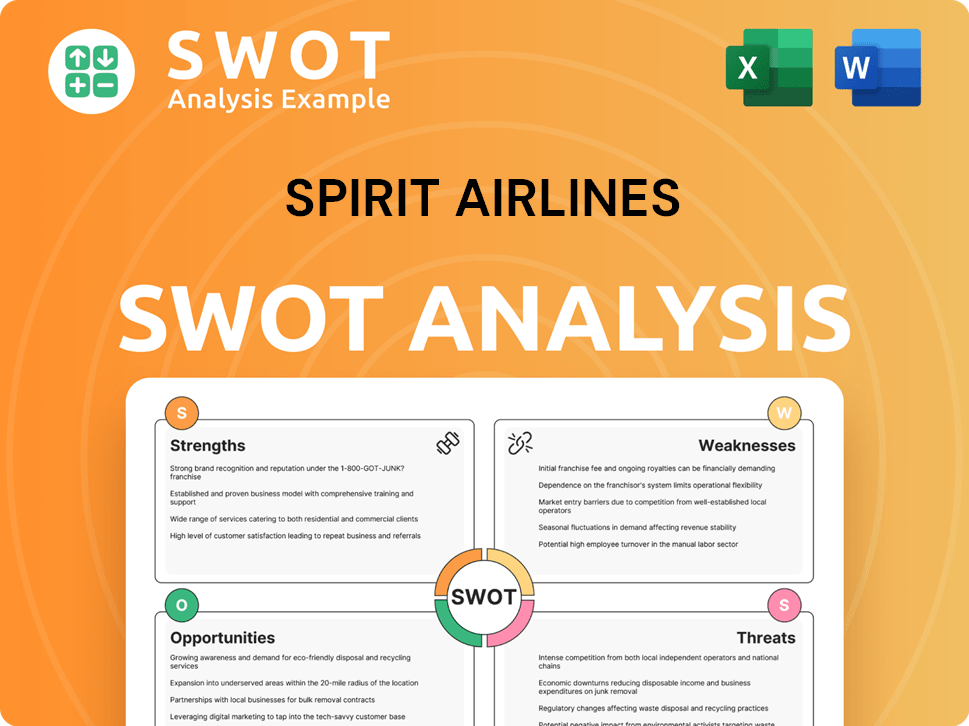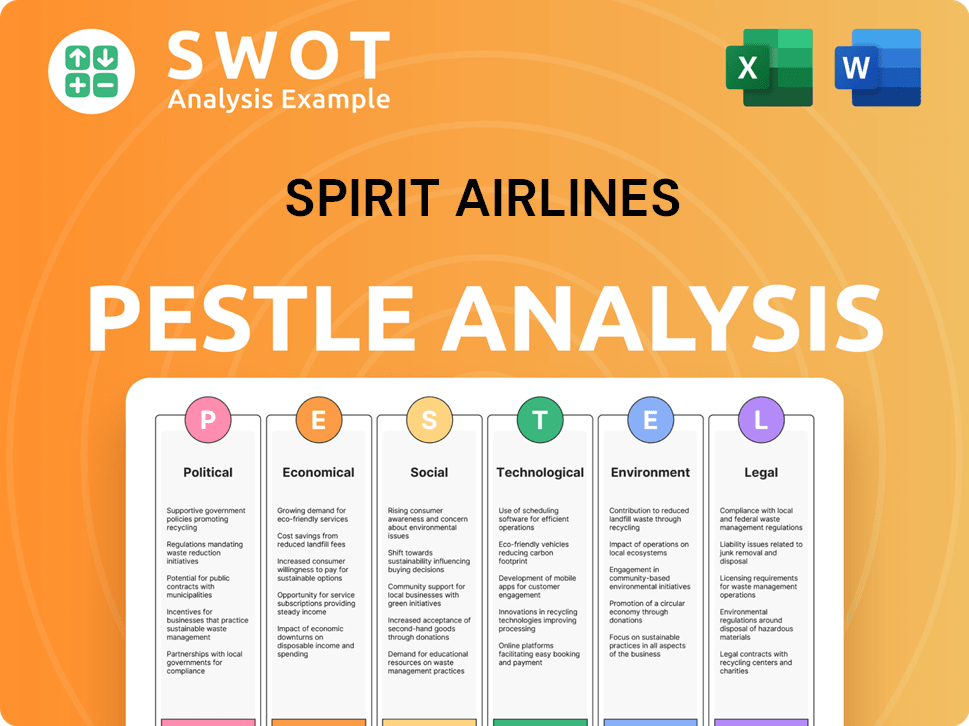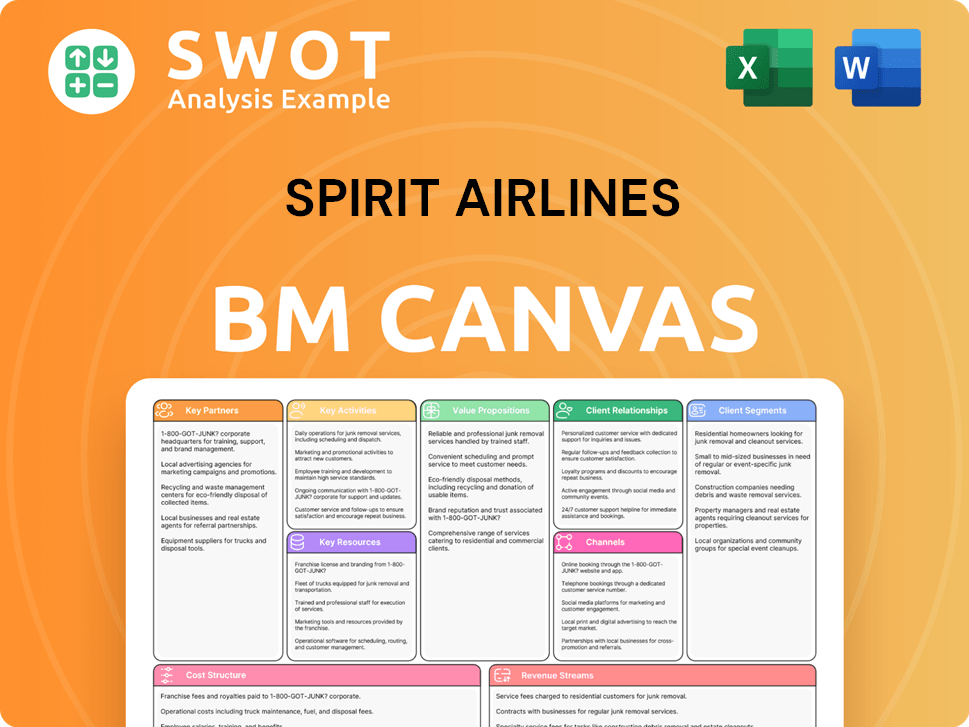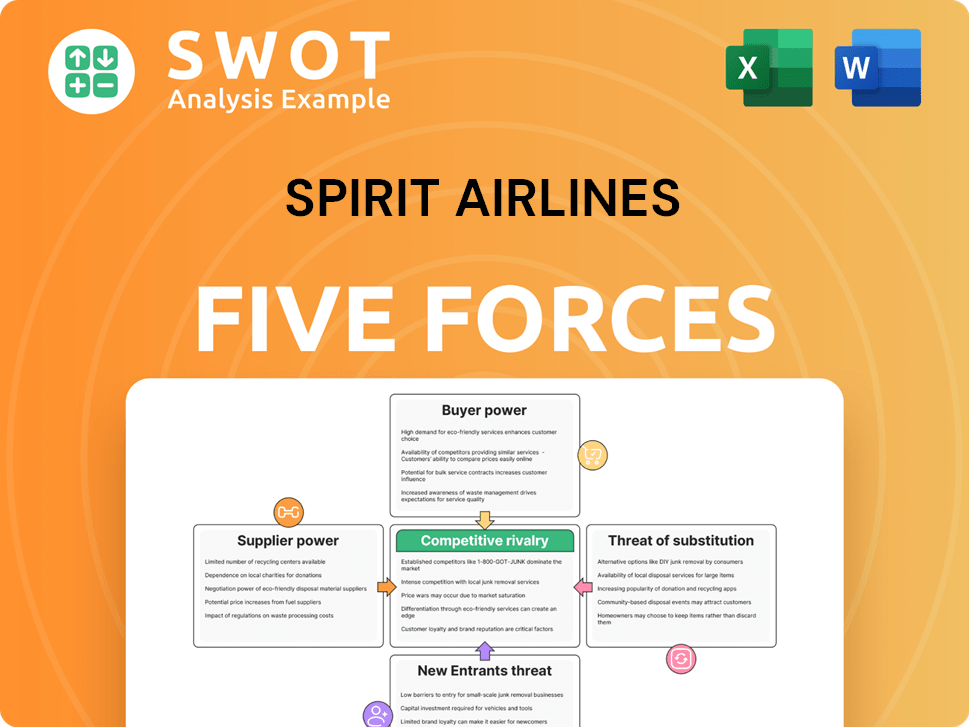Spirit Airlines Bundle
Can Spirit Airlines Soar Again in a Crowded Sky?
Spirit Airlines, a pioneer of the ultra-low-cost carrier (ULCC) model, has weathered turbulent skies, including a recent bankruptcy filing and restructuring. This Spirit Airlines SWOT Analysis provides a deep dive into the airline's strategies and market position. Understanding the Spirit Airlines competitive landscape is crucial for investors and strategists alike.

Following its emergence from bankruptcy in March 2025, Spirit Airlines is at a critical juncture, aiming to attract a broader customer base and redefine its business strategy. This analysis examines the airline's Spirit Airlines competitors, its evolving business strategy, and its prospects for long-term success in the fiercely competitive airline industry competition. We'll explore its market analysis to understand its challenges, including its Spirit Airlines market share 2024, and opportunities in the dynamic aviation sector.
Where Does Spirit Airlines’ Stand in the Current Market?
Spirit Airlines operates as an ultra-low-cost carrier (ULCC), focusing on budget-conscious travelers across the United States, Latin America, and the Caribbean. This positioning allows the airline to offer lower base fares by unbundling services and charging extra for amenities. This strategy is central to the airline's competitive approach within the airline industry competition.
As of November 2024, Spirit held a 4.9% domestic market share in the U.S. based on revenue passenger miles (RPMs), making it the sixth-largest airline in the U.S. Spirit's business model emphasizes ancillary revenue, such as baggage fees and seat selection, which is a key factor in its financial strategy. The airline has a significant geographic presence across the Americas, with a focus on high-traffic routes and strategic airport locations.
Spirit's core operations center on providing affordable air travel by minimizing operational costs and maximizing aircraft utilization. The airline's value proposition is built on offering low base fares, allowing customers to customize their travel experience and pay only for the services they need. This approach caters to a specific market segment that prioritizes price over in-flight amenities.
Spirit Airlines held a 4.9% domestic market share in the U.S. based on RPMs as of November 2024. This places Spirit as the sixth-largest airline in the U.S. This ranking highlights Spirit's significant presence within the competitive landscape.
Spirit Airlines has a broad geographic presence, serving destinations across the United States, Latin America, and the Caribbean. The airline strategically focuses on high-traffic routes and key airport locations to maximize its market reach. This network supports its ultra-low-cost model.
Spirit Airlines generates additional revenue through optional services and fees. This includes charges for baggage, seat selection, and other amenities. This strategy allows Spirit to offer low base fares while still generating significant revenue per passenger. This is a key aspect of its business model.
Spirit Airlines operates a fleet of 194 Airbus aircraft as of 2024, noted for its fuel efficiency. The airline focuses on maximizing aircraft utilization and minimizing operational costs. This efficiency is crucial for maintaining its ultra-low-cost structure.
Following its Chapter 11 bankruptcy filing in November 2024 and emergence in March 2025, Spirit Airlines is looking to pivot from solely targeting price-sensitive customers to attracting more affluent travelers. This strategic shift includes enhancing the passenger experience with new fare options, Wi-Fi, and improved loyalty rewards. The airline aims to generate 13% more revenue per passenger.
- Spirit reported a net loss of $1.2 billion in 2024, with operating revenue of $4.9 billion, an 8.4% decrease from 2023.
- The airline's operating margin was a negative 22.5% in 2024.
- Spirit secured $350 million in new equity investment and reduced its debt by $795 million upon exiting bankruptcy.
- The airline has reduced capacity in many markets, focusing on realigning its network to enhance operational reliability and profitability, while expanding in key areas like Miami International Airport.
Spirit Airlines SWOT Analysis
- Complete SWOT Breakdown
- Fully Customizable
- Editable in Excel & Word
- Professional Formatting
- Investor-Ready Format

Who Are the Main Competitors Challenging Spirit Airlines?
The Spirit Airlines competitive landscape is defined by intense rivalry in the airline industry. The company faces competition from various airlines, including both low-cost and traditional carriers. Understanding these competitors is crucial for analyzing Spirit Airlines market analysis and its strategic positioning.
Spirit Airlines competitors include ultra-low-cost carriers and major airlines, each employing different strategies to capture market share. The airline's business model, centered on low fares and ancillary revenue, puts it in direct competition with similar models. The dynamics are further complicated by mergers, alliances, and changing consumer preferences.
For more in-depth information, you can explore the Revenue Streams & Business Model of Spirit Airlines.
Spirit Airlines directly competes with other ultra-low-cost carriers and low-cost carriers. These airlines also focus on offering low base fares and generating revenue through ancillary services. This competitive environment drives the need for operational efficiency and cost management.
Ultra-low-cost carriers (ULCCs) are key rivals. These airlines, like Frontier Airlines and Allegiant Air, share a similar business model, emphasizing low fares and ancillary revenue. They compete directly on price and route offerings.
Major airlines, such as American Airlines, Southwest Airlines, United Airlines, and Delta Air Lines, also compete with Spirit Airlines. These airlines often have more extensive route networks and offer a broader range of services, but they also compete on price in certain markets.
Other airlines, including JetBlue Airways, SkyWest, Ryanair, Hawaiian Airlines, Viva Aerobus, British Airways, and WestJet, also pose competition. These airlines compete on specific routes or offer different service levels, impacting Spirit Airlines' market position.
The level of route overlap with competitors is a key factor. For example, American Airlines has the single largest overlap with Spirit Airlines, affecting approximately 51% of its markets. This overlap indicates significant direct competition on these routes.
Mergers and alliances influence the airline industry competition. The failed merger attempt between Spirit Airlines and JetBlue in 2024 highlights how consolidation could reshape the competitive landscape. Such events can alter market dynamics and impact Spirit Airlines' strategy.
Several factors drive competition in the airline industry, impacting Spirit Airlines' market position. These include pricing strategies, route networks, customer service, and ancillary revenue models. The ability to adapt to changing market conditions is crucial for success.
- Price Competition: Low fares are a primary competitive tool. Airlines constantly adjust prices to attract customers.
- Route Network: The breadth and depth of routes influence market share. Expanding or contracting routes affects competitive positioning.
- Customer Service: Customer satisfaction is a factor, even for ULCCs. Improving the customer experience can provide a competitive edge.
- Ancillary Revenue: Revenue from baggage fees, seat selection, and other services is a critical component of the business model.
Spirit Airlines PESTLE Analysis
- Covers All 6 PESTLE Categories
- No Research Needed – Save Hours of Work
- Built by Experts, Trusted by Consultants
- Instant Download, Ready to Use
- 100% Editable, Fully Customizable

What Gives Spirit Airlines a Competitive Edge Over Its Rivals?
The Marketing Strategy of Spirit Airlines centers on its ultra-low-cost carrier (ULCC) model, which has historically provided a significant competitive edge. This strategy allows the airline to offer exceptionally low base fares, attracting budget-conscious travelers. The airline's ability to maintain its position in the Spirit Airlines competitive landscape depends on its operational efficiency and ability to generate revenue from ancillary services.
A key element of the airline's strategy involves unbundling services, charging separately for amenities like seat selection and baggage. This approach allows the airline to keep base fares low while boosting profitability through non-ticket revenue streams. This strategy is crucial for competing effectively in the airline industry competition.
The airline's relatively young fleet, primarily consisting of Airbus A320neo family aircraft, is another significant advantage. This fleet is designed to enhance fuel efficiency, crucial in a volatile fuel market, and contributes to the airline's operational cost structure. The airline's focus on fuel efficiency and cost management is vital for its long-term sustainability.
The airline's ultra-low-cost model allows it to maintain some of the lowest unit operating costs in the industry. This cost structure is critical for offering competitive base fares. This cost advantage is a key factor in the airline's ability to compete effectively.
The airline's fleet, primarily composed of Airbus A320neo family aircraft, enhances fuel efficiency. This is a significant advantage, especially given the volatility of fuel prices. The 'Fit Fleet' strategy, centered on 236 Airbus A320neo aircraft, is projected to lower fuel burn by 15%.
Generating significant non-ticket revenue through unbundled services allows the airline to offer low base fares. This revenue stream is a crucial part of maintaining profitability. Ancillary revenue is a key component of the airline's financial strategy.
The airline has cultivated a distinct brand identity, appealing to budget-conscious travelers. Its reputation as a 'fun and quirky' alternative helps attract a specific customer segment. This brand recognition supports its competitive position.
The airline faces challenges, including the need to balance low-cost operations with enhanced amenities. The airline is also attempting to attract more affluent travelers. This strategic shift could impact its brand identity and cost structure.
- The airline is aiming to generate 13% more revenue per passenger.
- Redesigning loyalty programs and potential alliances are part of the new strategy.
- Maintaining low operating costs while attracting a different customer segment is crucial.
- The ability to adapt to changing market dynamics will be key to its success.
Spirit Airlines Business Model Canvas
- Complete 9-Block Business Model Canvas
- Effortlessly Communicate Your Business Strategy
- Investor-Ready BMC Format
- 100% Editable and Customizable
- Clear and Structured Layout

What Industry Trends Are Reshaping Spirit Airlines’s Competitive Landscape?
The airline industry is currently undergoing significant shifts that present both challenges and opportunities for ultra-low-cost carriers like Spirit Airlines. These changes include evolving consumer preferences, operational issues, and economic pressures. Understanding these dynamics is crucial for assessing the company's competitive position and future prospects. This analysis provides a detailed look at the competitive landscape, market trends, and strategic adjustments impacting Spirit Airlines.
Several factors influence the competitive dynamics of the airline industry. These include fluctuating fuel prices, labor costs, and the overall economic climate, all of which impact profitability and operational efficiency. The rise of hybrid models, where airlines blend low-cost and premium services, further complicates the competitive environment. These trends necessitate a flexible and strategic approach to maintain a strong market position.
Consumer preferences are shifting towards premium travel experiences. Operational challenges, such as engine issues with the Pratt & Whitney GTF, are impacting capacity. Economic uncertainty and rising labor costs are also key factors influencing the industry.
The shift away from ultra-low-cost models presents a challenge to Spirit's traditional strategy. Engine-related issues are expected to continue through 2026, affecting operations. Economic downturns and increased competition from other low-cost carriers will also impact performance.
Emerging from bankruptcy in March 2025 offers a chance for financial restructuring. Focusing on enhancing passenger experience and expanding the route network are strategic moves. Fleet modernization and strategic partnerships can boost competitiveness.
Spirit is aiming to attract more affluent travelers and increase revenue per passenger by 13%. The airline is rebranding as a 'premium airline' and introducing new fare bundles. Expansion of the route network and fleet modernization are also key strategies.
The airline industry is highly competitive, with numerous players vying for market share. Spirit Airlines faces competition from both legacy carriers and other ultra-low-cost carriers (ULCCs). The company's market analysis reveals its competitive advantages and disadvantages, particularly in terms of pricing, route networks, and customer service. Understanding the competitive landscape is essential for assessing Spirit Airlines' ability to compete effectively.
Spirit Airlines is focusing on a strategic pivot to attract more affluent travelers and increase revenue. Operational issues, particularly related to Pratt & Whitney GTF engines, are a major challenge. The company aims to leverage its emergence from bankruptcy to restructure financially and enhance its market position.
- Rebranding and Premiumization: Focusing on attracting more affluent travelers.
- Operational Restructuring: Addressing engine-related issues and streamlining operations.
- Route Network Expansion: Adding new domestic routes, including Raleigh/Durham, Nashville, and Indianapolis.
- Fleet Modernization: Adding six new A321neo aircraft in 2025.
Spirit Airlines Porter's Five Forces Analysis
- Covers All 5 Competitive Forces in Detail
- Structured for Consultants, Students, and Founders
- 100% Editable in Microsoft Word & Excel
- Instant Digital Download – Use Immediately
- Compatible with Mac & PC – Fully Unlocked

Related Blogs
- What are Mission Vision & Core Values of Spirit Airlines Company?
- What is Growth Strategy and Future Prospects of Spirit Airlines Company?
- How Does Spirit Airlines Company Work?
- What is Sales and Marketing Strategy of Spirit Airlines Company?
- What is Brief History of Spirit Airlines Company?
- Who Owns Spirit Airlines Company?
- What is Customer Demographics and Target Market of Spirit Airlines Company?
Disclaimer
All information, articles, and product details provided on this website are for general informational and educational purposes only. We do not claim any ownership over, nor do we intend to infringe upon, any trademarks, copyrights, logos, brand names, or other intellectual property mentioned or depicted on this site. Such intellectual property remains the property of its respective owners, and any references here are made solely for identification or informational purposes, without implying any affiliation, endorsement, or partnership.
We make no representations or warranties, express or implied, regarding the accuracy, completeness, or suitability of any content or products presented. Nothing on this website should be construed as legal, tax, investment, financial, medical, or other professional advice. In addition, no part of this site—including articles or product references—constitutes a solicitation, recommendation, endorsement, advertisement, or offer to buy or sell any securities, franchises, or other financial instruments, particularly in jurisdictions where such activity would be unlawful.
All content is of a general nature and may not address the specific circumstances of any individual or entity. It is not a substitute for professional advice or services. Any actions you take based on the information provided here are strictly at your own risk. You accept full responsibility for any decisions or outcomes arising from your use of this website and agree to release us from any liability in connection with your use of, or reliance upon, the content or products found herein.